As the world moves on from the Covid-19 pandemic, our understanding of the ocular impact of the SARS-CoV-2 virus (figure 1) continues to evolve. At the time of writing, there are still over 8,000 people in the UK in hospital with the disease and many more reporting symptoms that persist after infection. With most authorities suggesting that this recent pandemic is unlikely to be an isolated incident, it is important for all eye care professionals (ECPs) to understand the implications of such a disease upon eye health. This is the focus of this article.
Figure 1: Ultrastructural morphology exhibited by coronaviruses, such as (SARS-CoV-2) which causes the coronavirus disease Covid-19. The illustration, created at the Centers for Disease Control and Prevention (CDC), shows spikes on the outer surface of the virus and also the protein particles E, S, and M
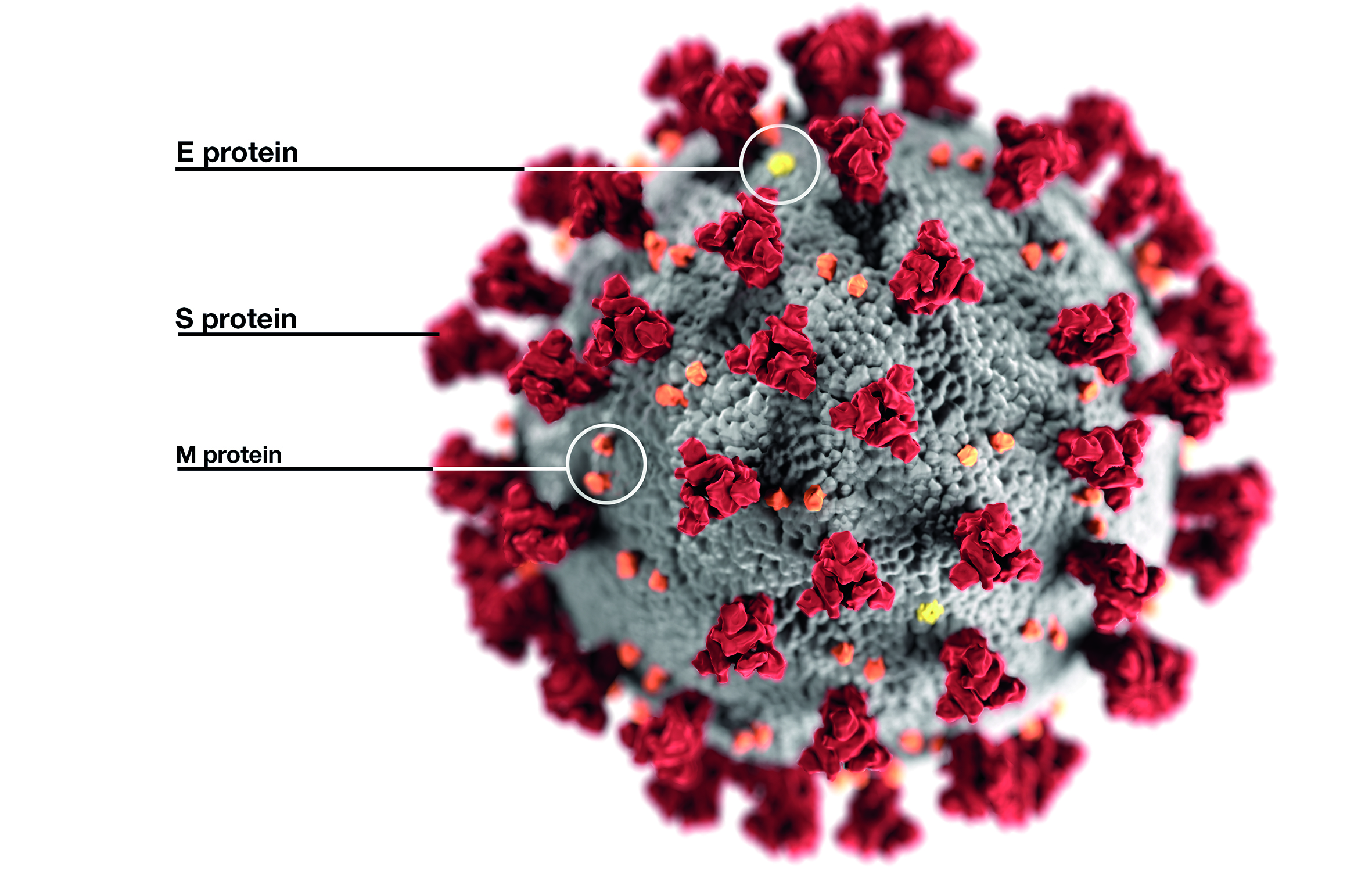
Epidemiology
According to the latest figures from the World Health Organisation (WHO), up to early March 2023 there have been 759,408,703 confirmed cases of Covid-19 worldwide, including 6,866,434 deaths, reported to the WHO. In the same time frame, the WHO also confirm that a total of 13,232,780,775 vaccine doses have been administered. In the UK, according to government data, the total number of people whose death certificate mentioned Covid-19 as one of the causes since the start of the pandemic currently sits at 219,466 (figure 2). While confirmed cases provide valuable information of extent of infection, the actual number of cases is understood to be several times this value.
Figure 2: A section of the National Covid Memorial Wall on the Thames embankment. At the time of publication, the number of reported UK deaths due to Covid-19 is 219,466

As an indication of this, Qasmieh et al undertook a cross-sectional survey of a population-representative sample of 3,042 adults in the US between June 30 and July 2, 2022, at the height of the Omicron variant surge. Using a variety of predictive methods based on the survey content, an estimated 17.3% of subjects had the SARS-CoV-2 infection during the two-week study period. This equated to 44 million cases across the USA1 and compared with the 1.8 million cases reported by the Centre for Disease Control (CDC) over the same time period. Epidemiological models of Covid-19 also predict higher levels of the true number of infections.2
Short-Term Effects of SARS-CoV-2 Virus on the Ocular System
A range of studies of the effects of the SARS-CoV-2 virus upon the ocular system focus on immediate observations that present during acute stages of infection. Feng et al published one study of 400 hospital patients with confirmed Covid-19 infection where 9.5% (38 cases) of patients had developed ocular abnormalities of various types.3 The main distribution of ocular symptoms is described as conjunctival injection 39.5% (figure 3), vision changes 23.7%, irritation 21.1%, discharge 18.4%, itching 7.9% and scleral haemorrhage 5.3%. Observations within this study indicate that symptoms of eye problems can often be overlooked during periods of acute hospitalisation where patients are later surveyed by phone. Also, within the acute Covid-19 clinic environment, assessment of the patient condition by trained ophthalmologists was less likely and probably resulted in ocular abnormalities being missed.
Figure 3: Conjunctival hyperaemia is a common sign of acute Covid-19 infection
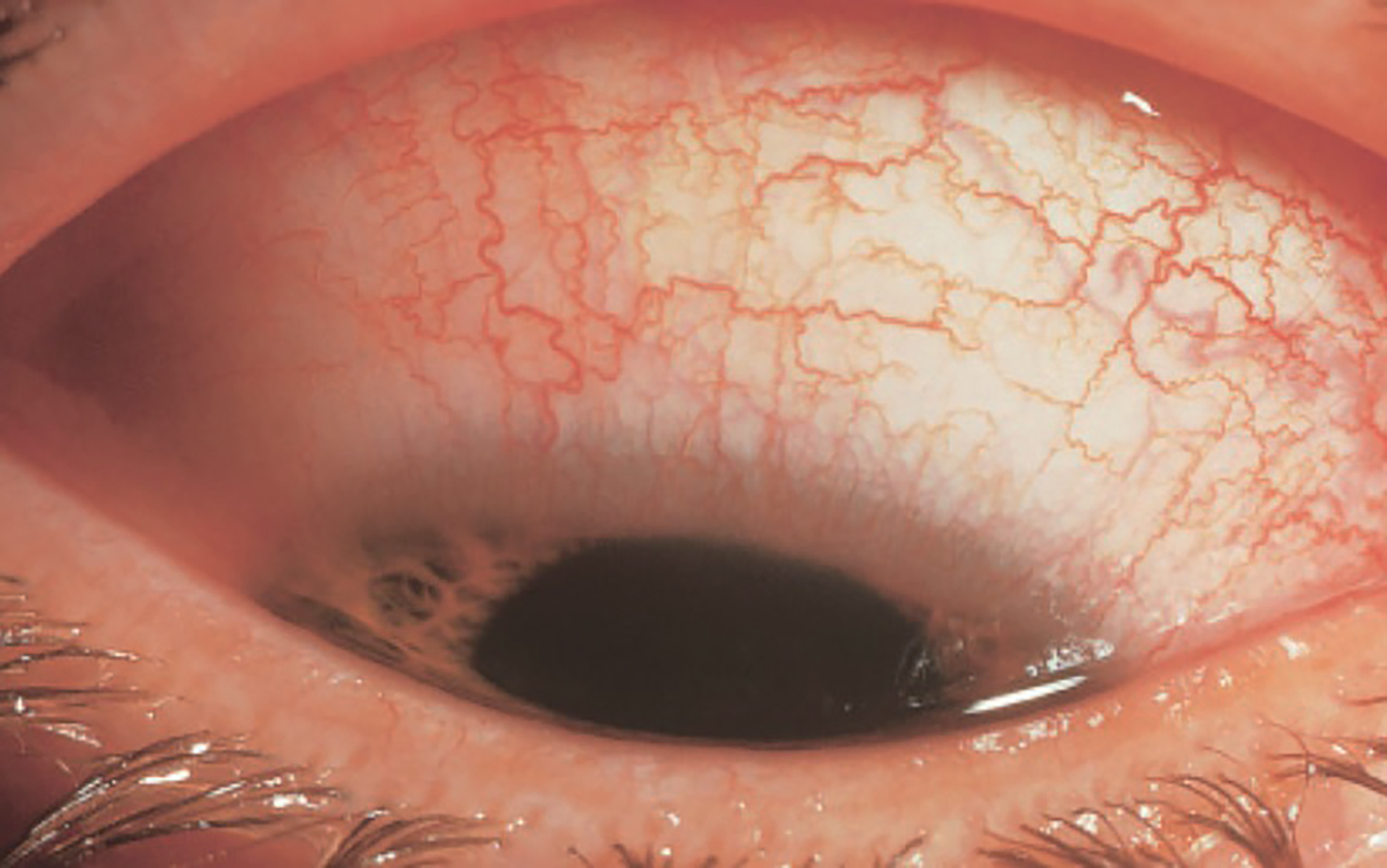
A systematic review by Nasiri et al of 85 selected studies, from both inpatient and outpatient environments, reported a more detailed set of ocular occurrences associated with Covid-19 based on reported symptoms of 1,021 patients.4 The top symptoms of 932 reported are described as:
- Dry eye or foreign body sensation 16.0%
- Redness 13.3%
- Tearing 12.8%
- Itching 12.6%
- Eye pain 9.6%
- Discharge 8.8 %
In the process of reporting findings, however, there is overlap between similar descriptions. In terms of disease reporting within 89 cases, the dominant one is that of conjunctivitis, reported by 88.8% (figure 4).
Figure 4: The dominant short-term effect of the SARS-CoV-2 virus upon the ocular system is viral conjunctivitis
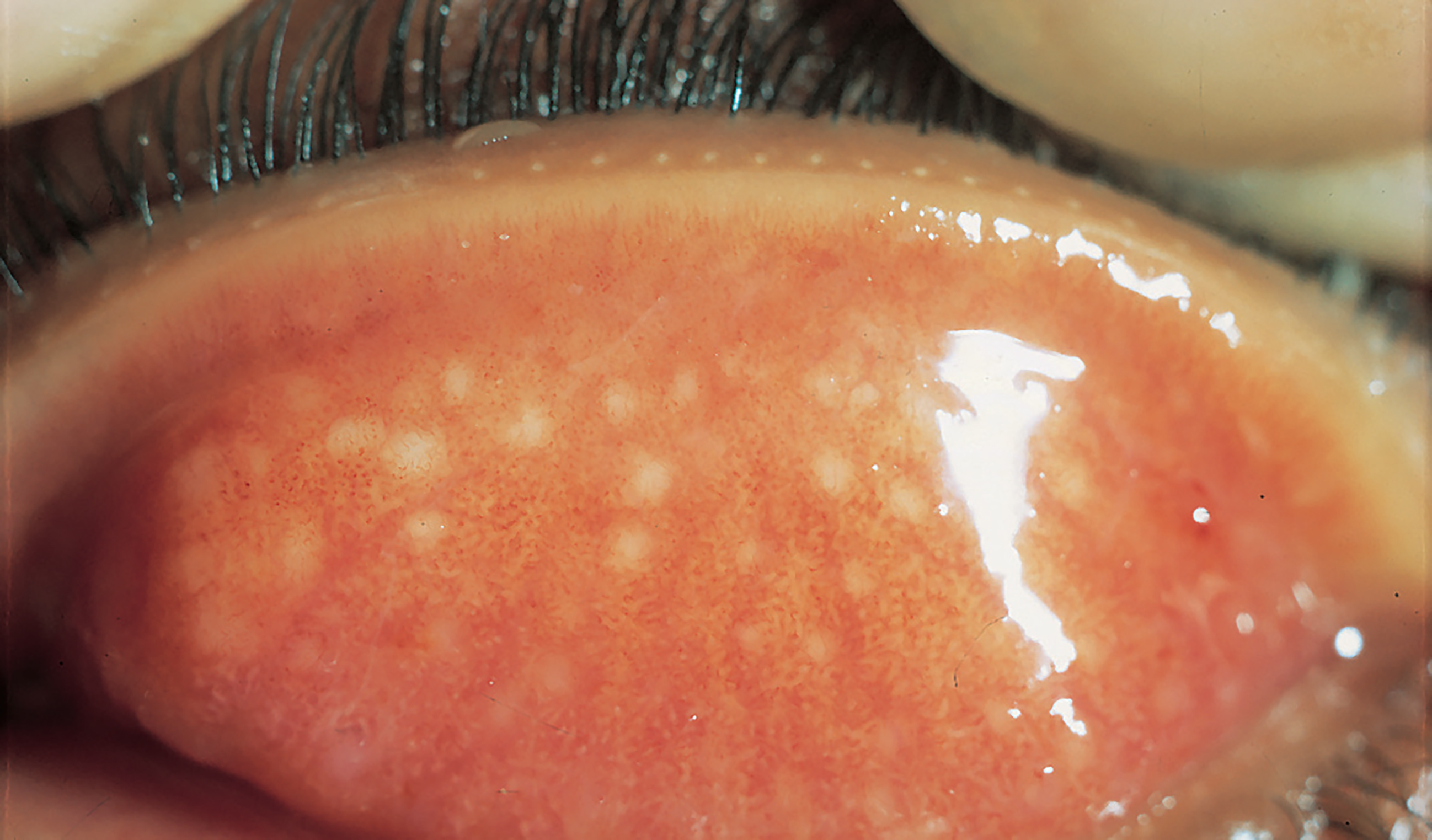
Coco-Martín et al identified visual perception disturbances, specifically colour and chromatic-achromatic contrast vision changes, in a group of 25 patients hospitalised with Covid-19.5 It was not clear, however, if this was due to involvement of the ocular surface, the retina or the visual pathways. They concluded that further research is required here.
Long-Term Effects of SARS-CoV-2 Virus on the Ocular System
In general, full understanding of the impact of the SARS-CoV-2 virus upon the eye is at an early stage. Many eye conditions present after a gradual deterioration/decline in cellular activity and the SARS-CoV-2 virus has the potential to accelerate such a trend.
Endothelial cells, for example, whose critical function is to preserve the transparency of the cornea, are potentially at risk from such infection and studies to assess active cell density changes with Covid-19 are especially relevant. With ageing and damage to endothelial cells, adaptation takes place through cell expansion, cell migration and amitotic nucleus division (figure 5). This results in a reduction in cell density, an increase in the coefficient of variation of cell size (pleomorphism) and an increase in the average cell size (polymegathism).
Figure 5: (a) Typical normal cell distribution of the endothelium. (b) Example of cell distribution of the endothelium showing polymegathism (Courtesy: Konan Medical USA Inc)
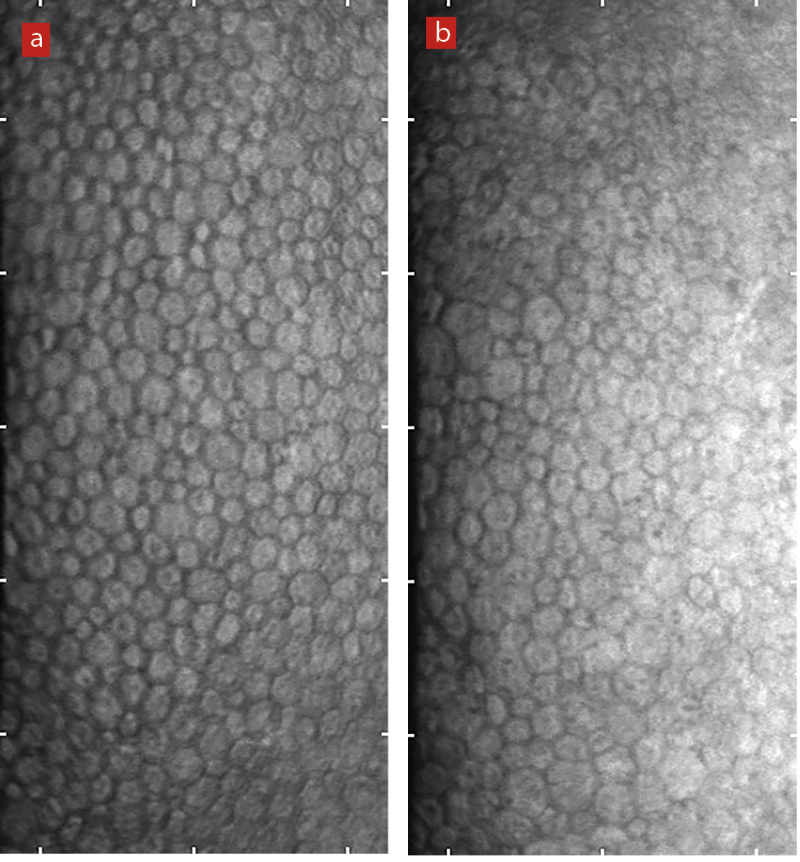
Erdem et al published a study where the endothelial cell characteristics of a group of patients recovering from Covid-19 were compared with a control group based on images obtained by a specular microscope.6 Specific scans were used to image at least 100 separate cells. Analysis of the images indicated a decrease in the number of endothelial cells and hexagonal cells and also an increase in the cell area change coefficient and the average cell area of individuals recovering from Covid-19 in the early period of the disease. Oren et al observed broadly similar findings to these, though also suggested that additional studies of larger groups are required to confirm these initial observations.7
Possible Vaccination Side Effects
Ng et al have looked in detail at the reported ocular side effects attributed to the use of Covid-19 vaccines (figure 6), referencing specific case histories.8 The element of caution raised in describing attributed side effects, however, is directed to possible identification of patient groups that may require a greater degree of monitoring of such ocular side effects rather than identification of patient groups for which vaccination would be an unacceptable risk.
Figure 6: Rare ocular side effects of vaccination appear to have been managed successfully
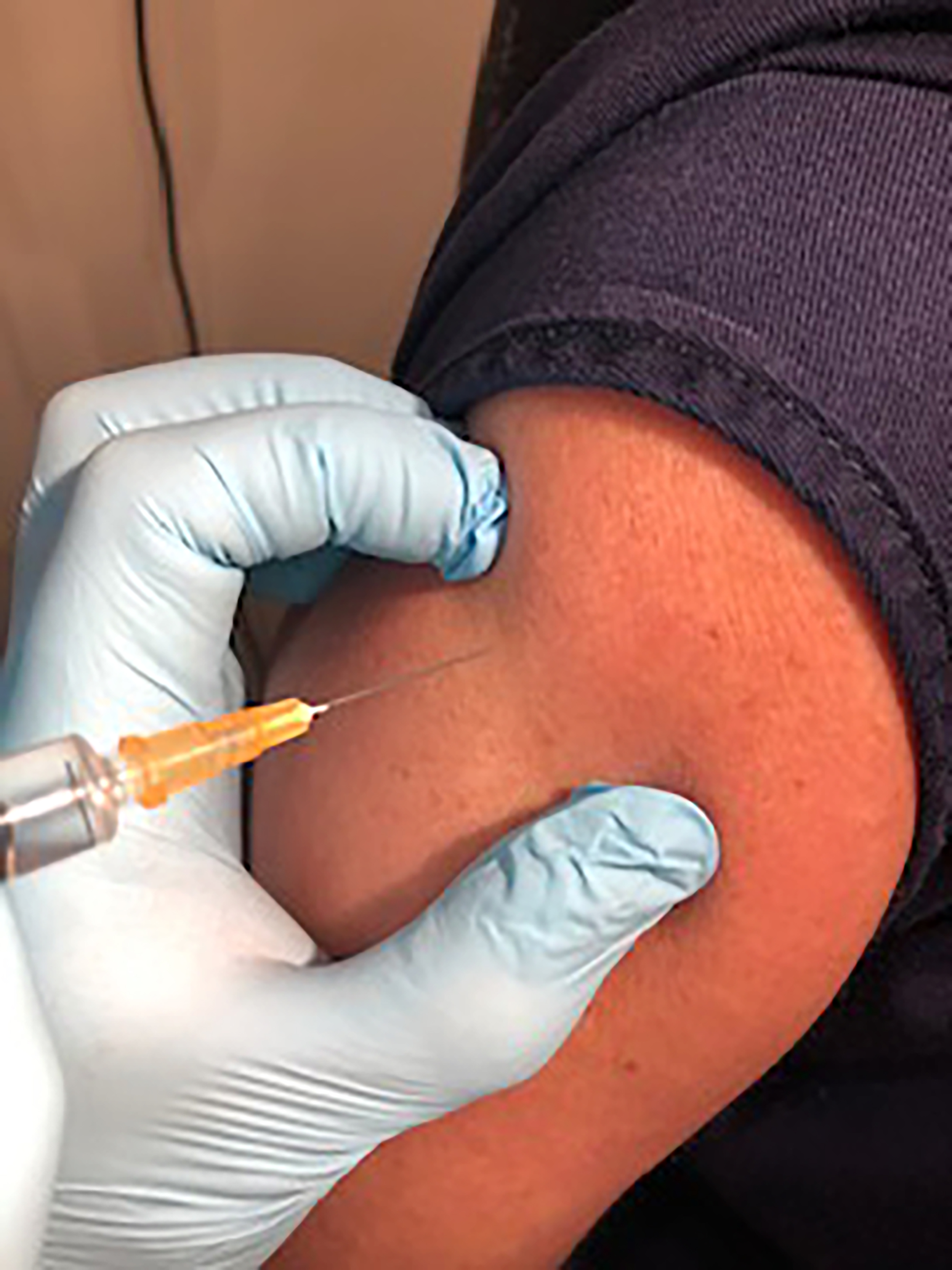
The summary of related case histories identifies ocular occurrences, which presented immediately after vaccination, as well as those in days and weeks following. Case histories include examples of adverse responses, such as the onset of corneal graft rejection. These were successfully treated using oral and topical corticosteroids and, in general, potential side effects associated with vaccination appear to have been managed successfully.
Phylactou et al describe two cases of endothelial corneal allograft rejection following immunisation with SARS-CoV-2 (mRNA) BNT162b2 vaccine.9 In one case, the vaccine was administered 14 days after DMEK transplantation, whereupon indications of graft rejection were observed seven days post-procedure, though resolved satisfactorily with steroid administration. In the other case, graft rejection was observed in bilateral DMEK transplantation undertaken three and six years previously and where symptoms of rejection were observed two months after the first dose and three weeks after the second dose of SARS-CoV-2 (mRNA) BNT162b2 vaccine. Again, treatment with steroids resolved the condition. The authors comment, however, that their observations do not provide grounds for any delay of vaccination, though the delay of non-urgent keratoplasties in unvaccinated patients to allow them to receive Covid-19 vaccination prior to surgery may be an appropriate approach.
Ocular Effects through Drug Interactions
Akbari and Dourandeesh have reported on how the effects of the SARS-CoV-2 virus can be attributed directly to the virus itself and also to the various drugs utilised to manage the patient.10 Concerns, for example, regarding the use of chloroquine and hydroxychloroquine and their ability to induce retinal toxicity (figure 7) re-emerged, though these effects predated the Covid-19 pandemic.11 While there was initial anticipation that chloroquine and hydroxychloroquine would be effective in the management of Covid-19 symptoms, more rigorous trials (as described, for example, by Gupta and Malviya) indicated that the drugs were not effective.12
Figure 7: Chloroquine maculopathy
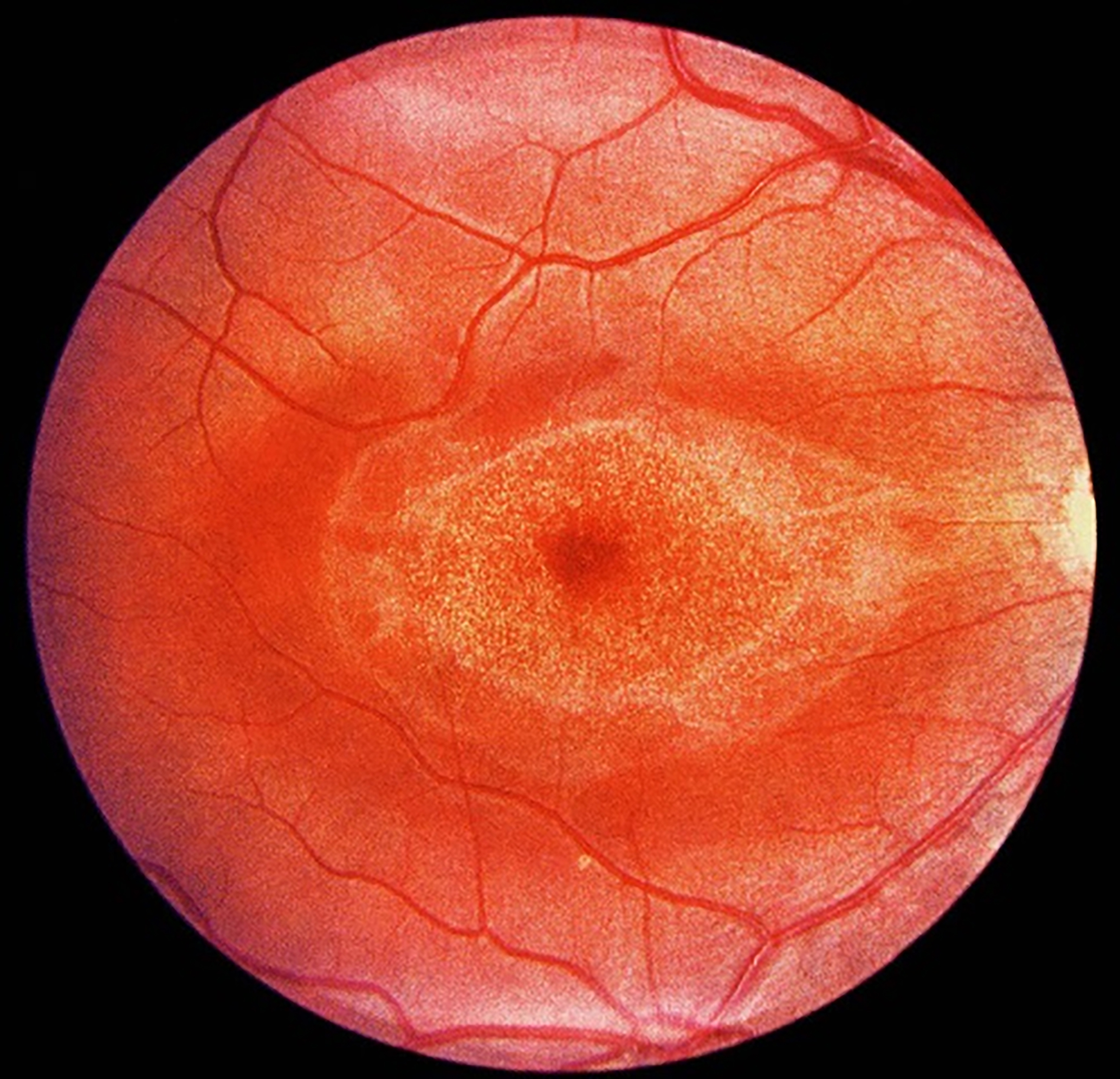
Abtahi et al further described important potential ocular side effects arising from the medication received by Covid-19 patients.13 It is common practice for hospitalised Covid-19 patients to receive glucocorticoids (corticosteroids) in order to counteract systemic inflammation and, within this group, dexamethasone is widely administered. There is strong evidence,14 of the link between the use of glucocorticoids and a number of long-term ocular complications, such as cataracts and glaucoma (figure 8), based on monitoring of patients receiving glucocorticoids for rheumatic arthritis. In this study, there was evidence of increased incidence of glaucoma at dosages in excess of 7.5mg/day, though the threshold for cataracts was less than 5mg/day.
The increased use of glucocorticoids during the Covid-19 pandemic with their related potential ophthalmic side effects, however, needs to be placed in perspective in relation to the prevailing widespread use of such drugs. Razeghinejad and Katz have stated that patients previously diagnosed with glaucoma are at risk of deterioration of their condition through glucocorticoids use.15
Figure 8: Known ocular effects of corticosteroid drugs include (a) posterior subcapsular cataract and (b) glaucoma
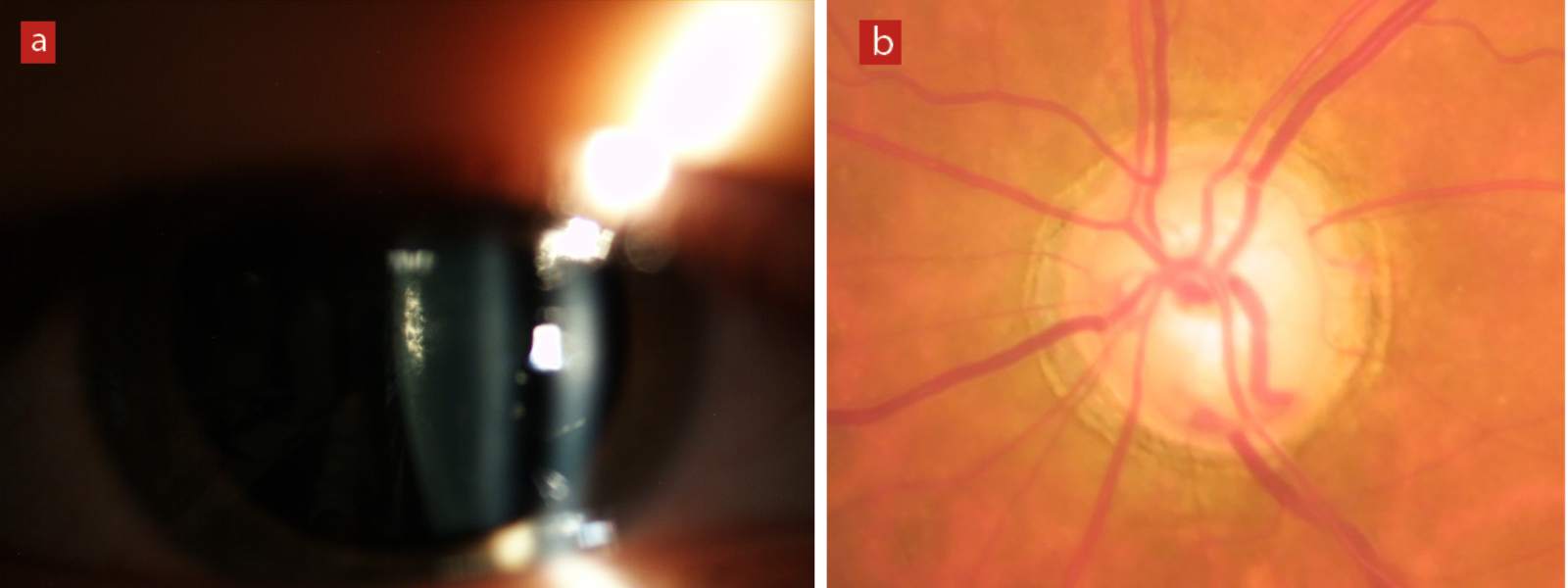
Disruption of Metabolic Pathways
The ability of the SARS-Cov-2 virus to disrupt key metabolic pathways in the body can also have significant subsequent impact on ocular health. The observation of higher incidence levels of new-onset type 1 diabetes within paediatric patients during the pandemic has been variously reported, though not confirmed by all. Kendall et al, for example, indicate a positive finding while other studies, such as those of Tittel et al, report no such causative link.16, 17
The study by Kendall et al, made comparisons between groups of patients with various respiratory complaints and found the higher incidence of new-onset type 1 diabetes patients identified with Covid-19.16 There is the potential, however, for the interplay of many factors in appraising such a link, such as the variants of the virus to which individuals were exposed and also the number of potential re-infections of the virus that occurred. The development of new-onset type 1 diabetes would, in turn, present an increased risk of subsequent development of diabetic retinopathy.
Disruption of Clinical Services
The disruption of ophthalmic services on account of the pandemic is widely reported and has probably resulted in the deterioration of eye conditions that normally would have been appropriately managed. Wood et al describe the serious disruption of paediatric ophthalmology services in the United Kingdom during the first phase of the virus.18 The survey published by Waisberg et al describes a general increase in disease severity and a decrease in medication and examination compliance one year after the beginning of the Covid-19 pandemic; in particular, conditions relating to macular degeneration were highlighted.19 Careful resource planning and patient engagement has been shown, however, to allow for safe resumption of cataract surgery.20
The Covid-19 pandemic has significantly impacted upon corneal donor banks and corneal transplantations. Aiello et al provide a comprehensive review of these altered patterns of activity and have shown that a reduction of around 20% of corneal tissue procurement during 2020 is typically reported by major groups, such as the Eye Bank Association of America.21 To increase the efficiency of use of eye bank tissue, Aiello et al suggest the possibility of increased use of multiple grafts from a single donor cornea and that the preparation of such grafts could be an additional eye bank function.21 Standard operating procedures at eye bank centres were variously altered to include diverse checks relating to potential Covid-19 exposure of donors.22 The procedure, for example, of double disinfection of donor corneas, using agents such as povidone iodine, was widely adopted. The Covid-19 pandemic, however, has led to a widespread review of procedures within eye banks and to hopefully provide greater stability in the post-pandemic era.
While several thousand clinical papers have been published on prevention and management of Covid-19, medical research including that relating to the human visual system, has been significantly disrupted.
Evolving Preventive Measures
Preventive measures to reduce the impact of the SARS-CoV-2 virus during the pandemic stages were initially unclear. While UVC ultraviolet radiation has been previously employed as a means of decontamination of healthcare environments, this has tended to use the so-called germicidal wavelength of 254nm. While effective against a range of pathogens, this wavelength does not allow direct exposure to eye and skin and so cannot be used in a routine work environment. The use of krypton chloride (KrCl) excimer lamps (often referred to as far-UVC), which can efficiently inactivate a range of airborne pathogens, is a potential means of reducing concentrations of airborne SARS-CoV-2 virus within specific environments.
When KrCl lamps are filtered to exclude wavelengths greater than 230nm, they do not induce acute reactions in the skin or eyes, nor induce mutagenic effects, and can be effectively utilised at consistent levels for eight hours of occupational exposure (based on ICNIRP safety limits)23, 24 (figure 9). A description of the operation of such a system is detailed by Eadie et al25 In this work, significant reductions of airborne Staphylococcus aureus were achieved using far-UVC technology in a room-sized test environment, where the pathogen reduction was equivalent to 35 air changes per hour (ACH) consistent with appropriate setting to comply with ICNIRP eight-hour exposure levels.
Figure 9: Anticipated use of far-UVC radiation in diverse public spaces. (Courtesy Columbia University Irving Medical Center)

There is an obvious potential for the widespread deployment of such technology within healthcare facilities, including eye care premises, as a preventive measure against common airborne viruses, including SARS-CoV-2, which is not reliant on human behaviour. The current research team will continue their investigation into the safety and efficacy of far-UVC lights with the help of additional funding from the UK Health Security Agency and NHS Scotland Assure.
The current advice from the College of Optometrists regarding ventilation of premises is: ‘You must comply with appropriate health and safety measures for adequate ventilation throughout the practice.’ There is an obvious need, however, for regulatory authorities to catch up with the evolving science to develop safer work environments for both the public and work staff. It is of interest that, in 2022, the Scottish government made provision of funding for the upgrading of ventilation of eye care premises to which the general public has access.
Drug Shortages
The Royal College of Ophthalmologists works with the UK Ophthalmic Pharmacy Group to provide information on drug shortages. While specific shortages may have emerged during the various phases of the Covid-19 pandemic, there would appear to be no current significant supply issues, though fragilities remain in complex supply chain dynamics, which face potential disruption from factors such as climate change, Brexit and on-going and developing geopolitical tensions.
Final Thought
The concept of ‘getting back to normal’ in terms of the Covid-19 pandemic has been widely embraced by most countries around the world. The reality is that the virus continues to be a hazard, though its worst effects have been blunted by vaccination campaigns. The identification of the effect of Covid-19 on ocular health is further complicated by the evolution of the virus itself and, as new variants emerge and become dominant, different sets of patient symptoms become evident. This represents a challenge to reporting mechanisms within medical literature.
During February 2023 in the United Kingdom, it is sobering to reflect that Covid-19 was involved in 3.5% deaths at a time when 2.5% of the population were infected with the virus. This is equivalent to the number of passengers on a Boeing 747 dying each week.
- Dr Douglas Clarkson is a research fellow at the department of clinical physics and bio-engineering, Coventry and Warwickshire University Hospital Trust.
References
- Qasmieh SA, Robertson MM, Teasdale CA, Kulkarni SG, Jones HE, McNairy M, Borrell LN, Nash D. The prevalence of SARS-CoV-2 infection and long Covid in U.S. adults during the BA.4/BA.5 surge, June-July 2022. Preview of Medicine, 2023 Feb 20;169:107461
- Phipps SJ, Grafton RQ, Kompas T. Robust estimates of the true (population) infection rate for Covid-19: a backcasting approach. Royal Society of Open Science, 2020 Nov 18;7(11):200909
- Feng Y, Park J, Zhou Y, Armenti ST, Musch DC, Mian SI. Ocular manifestations of hospitalized Covid-19 patients in a tertiary care academic medical center in the United States: A cross-sectional study. Clinical Ophthalmology, 2021 Apr 13;15:1551-1556
- Nasiri N, Sharifi H, Bazrafshan A, Noori A, Karamouzian M, Sharifi A. Ocular Manifestations of Covid-19: A Systematic Review and Meta-analysis. Journal of Ophthalmic Vision Research, 2021 Jan 20;16(1):103-112
- Coco-Martín MB, Leal-Vega L, Alcoceba-Herrero I, Molina-Martín A, de-Fez D, Luque MJ, Dueñas-Gutiérrez C, Arenillas-Lara JF, Piñero DP. Visual perception alterations in Covid-19: a preliminary study. International Journal of Ophthalmology, 2023 Jan 18;16(1):1-9
- Erdem S, Karahan M, Ava S, Dursun ME, Hazar L, Keklikci U. Examination of the effects of Covid-19 on corneal endothelium. Graefes Archives of Clinical & Experimental Ophthalmology, 2021 Aug;259(8):2295-2300
- Oren B, Kocabas DO. Assessment of corneal endothelial cell morphology and anterior segment parameters in COVID-19. Therapeutics and Advanced Ophthalmology, 2022 May 9;14:25158414221096057
- Ng XL, Betzler BK, Ng S, Chee SP, Rajamani L, Singhal A, Rousselot A, Pavesio CE, Gupta V, de Smet MD, Agrawal R. The Eye of the Storm: Covid-19 Vaccination and the Eye. Ophthalmology and Therapeutics, 2022 Feb;11(1):81-100
- Phylactou M, Li JO, Larkin DFP. Characteristics of endothelial corneal transplant rejection following immunisation with SARS-CoV-2 messenger RNA vaccine. British Journal of Ophthalmology, 2021;105:893–896
- Akbari M, Dourandeesh M. Update on overview of ocular manifestations of Covid-19. Frontiers of Medicine (Lausanne), 2022 Sep 13;9:877023. doi: 10.3389/fmed.2022.877023
- Nicolò M, Ferro Desideri L, Bassetti M, Traverso CE. Hydroxychloroquine and chloroquine retinal safety concerns during Covid-19 outbreak. International Ophthalmology, 2021 Feb;41(2):719-725
- Gupta A, Malviya A. Chloroquine and hydroxychloroquine for Covid-19: time to close the chapter. Postgraduate Medical Journal, 2021 Oct;97(1152):676-677
- Abtahi SH, Nouri H, Moradian S, Yazdani S, Ahmadieh H. Eye Disorders in the Post-Covid Era. Journal of Ophthalmic Vision Research, 2021 Oct 25;16(4):527-530
- Huscher D, Thiele K, Gromnica-Ihle E, Hein G, Demary W, Dreher R, et al. Dose-related patterns of glucocorticoid-induced side effects. Annals of Rheumatoid Disease, 2009;68:1119–1124
- Razeghinejad MR, Katz LJ. Steroid-induced iatrogenic glaucoma. Ophthalmic Research, 2012;47(2):66-80
- Kendall EK, Olaker VR, Kaelber DC, Xu R, Davis PB. Association of SARS-CoV-2 infection with new-onset type 1 diabetes among pediatric patients from 2020 to 2021. JAMA Network Open, 2022 Sep 1;5(9):e2233014
- Tittel SR, Rosenbauer J, Kamrath C, Ziegler J, Reschke F, Hammersen J, Mönkemöller K, Pappa A, Kapellen T, Holl RW; DPV Initiative. Did the Covid-19 lockdown affect the incidence of pediatric type 1 diabetes in Germany? Diabetes Care,2020 Nov;43(11):e172-e173
- Wood M, Gray J, Raj A, Gonzalez-Martin J, Yeo DCM. The impact of the first peak of the Covid-19 pandemic on a paediatric ophthalmology service in the United Kingdom: experience from Alder Hey Children’s Hospital. British and Irish Orthoptics Journal, 2021 Mar 25;17(1):56-61
- Waisberg E, Ong J, Zaman N, Kamran SA, Tavakkoli A, Lee AG. The impact of Covid-19 on managing ophthalmic diseases: an international, descriptive study. Irish Journal of Medical Science, 2023 Feb 11:1–3
- Al Hassan H, Haq A, Yang E, Mensah E. Resuming cataract surgery in a high-risk Covid-19 population. BMJ Open Qual., 2021 Jun;10(2):e001116
- Aiello F, Gallo Afflitto G, Pocobelli G, Ponzin D, Nucci C. Effect of Covid-19 on eye banks and corneal transplantations: Current Perspectives. Clinical Ophthalmology, 2022 Dec 30;16:4345-4354
- Ballouz D, Mian SI. Eye banking in the coronavirus disease 2019 era. Current Opinions in Ophthalmology, 2020 Sep;31(5):389-395
- Barnard IRM, Eadie E, Wood K. Further evidence that far-UVC for disinfection is unlikely to cause erythema or pre-mutagenic DNA lesions in skin. Photodermatology, Photoimmunology and Photomedicine, 2020 Nov;36(6):476-477
- International Commission on Non-Ionizing Radiation Protection (ICNIRP). Guidelines on limits of exposure to ultraviolet radiation of wavelengths between 180 nm and 400 nm (incoherent optical radiation). Health Physics, 2004 Aug;87(2):171-86
- Eadie E, Hiwar W, Fletcher L, Tidswell E, O’Mahoney P, Buonanno M, Welch D, Adamson CS, Brenner DJ, Noakes C, Wood K. Far-UVC (222 nm) efficiently inactivates an airborne pathogen in a room-sized chamber. Science Reports, 2022 Mar 23;12(1):4373
